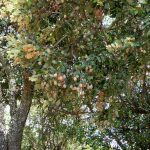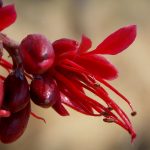TREE LIFE
DECEMBER 1989
MASHONALAND CALENDAR
Saturday 2nd December: is Tree Planting Day
Tuesday 5th December: Botanic Garden Walk. Park your car at the Herbarium where we will meet at 1645 hours for 1700 hours. More about acacias we hope.
Sunday 10th December: If the weather is kind, we will gather at Cleveland Dam at about 1000 hours for an informal Christmas get-together.
Saturday 30th December: EXTRA MUKUVISI WOODLAND WALK
In previous years the December Mukuvisi Woodland walk on the fourth Saturday of the month has been cancelled because it obviously falls too inconveniently near to Christmas. This year, I am proposing simply to post pone it a week to 1500 hours on Saturday December 30th. The time of the year is a very interesting one for trees and plants and it seems a pity to miss it.
I am also proposing to change the venue slightly so that we shall meet in Blatherwick Avenue and explore a slightly different area of the Mukuvisi Woodland this time. To get to Blatherwick Avenue, coming out of Harare on the Widdecombe Road, do not turn off left down Tokwe Road and hence into Paget, but continue on and turn left into Longford Avenue. The second left turning off Longford brings you down to the Mukuvisi Woodland.
For future walks on the fourth Saturday I feel it may make it more interesting if the venue is changed from time to time, possibly to include other interesting areas near to Harare, for example Cleveland Dam. As a help to learners it might also be useful to concentrate on particular groups of trees, which could be announced in advance.
If anyone knows of particularly interesting areas preferably within or very near to Harare, I would be very interested to hear from them. My home phone number is 701023.
-Mark Hyde
MATABALELAND CALENDAR
On Sunday, December 3rd we go to Shumba Shaba Mkulu, Mr Roy Stevens Farm about 54km out on the Old Gwanda Road (just beyond the Matopo Mission). Meet at Retreat at 0830 hours. We go via the Matopos Road, turning left to Fort Usher, on to the Old Gwanda Road. We will be guided from there. Three perennial streams mystery trees and unusual ferns await us. An all day outing, bring lunch.
MATABELELAND NOTES :
On Sunday November 5th we went to Amalundu some 28km from Bulawayo, looking towards Esigodini. A most interesting area with a magnificent view and a good variety of species. We identified some 60 species in a good morning’s outing, with some steep walking. Indeed one member said that it needed our monthly outing to tell her how unfit she was. We also had a very good attendance of 35, so things are looking up.
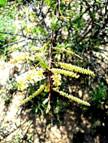
Acacia chariessa. Photo; L. E. Lauritsen. Source: Flora of Zimbabwe
There were 6 Acacias, A. chariessa, A. gerrardii, A. karroo, A. nilotica, A. rehmanniana, A. sieberana, Berchemia zeyheri, Brachystegia glaucescens, Canthium lactescens, Carisa edulis flowering, Cassine matabelica, many with soft, young leaves, contrasting with some old and tough Cassine transvaalensis, Catha edulis, Celtis africana, Combretum apiculatum, flowering, C. erythrophyllum down by the Spring and stream, showing its “Lion’s Claw” markings on the bark, C. hereroense, C. molle, mainly young Croton gratissimus, Diospyros lycioides, D. mespiliformis, flowering Dovyalis caffra, with some long spines, Ehretia rigida flowering Euclea divinorum, E. natalensis, Euphorbia cooperi, E. ingens, Faurea saligna flowering well, Flacourtia indica, Flueggea virosa (Securinega), Grewia flavescens, G. monticola, Heteropyxis dehniae, quite aromatic, Maytenus undata some with white bloom below, Mimusops zeyheri, Pappea capensis, Pavetta eylesii, P. gardenifolia (assimilis), Protea gaguedi, Psydrax livida, (Canthium huillense), Rhus pyroides, R. tenuinervis and a sub shrub Rhus with many narrow leaves many very red, Schrebera alata, Tapiphyllum velutinum, Tetradenia brevispicata (Iboza), Tarchonanthus camphorates, Zanthoxylum capensis and some youngish Ziziphus mucronata.
-C. Sykes.
BOTANIC GARDEN WALK : NOVEMBER 1989
We ploughed on with the Acacias! Though they are numerous and confusing, Tom’s logical classification into groups simplifies things considerably.
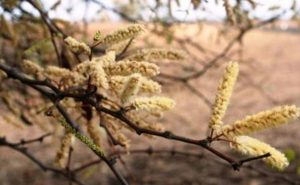
Acacia nigrescens. Photo: Petra Ballings. Source: Flora of Zimbabwe
We recapped briefly on the previous walk by looking again at A. nigrescens (knobthorn) and A. goetzei. these both fall within the group with paired hooked thorns (which are NOT modified stipules) and generally catkin-like flowers. The latter was in full flower.
Part 2 of Acacias was these with scattered hooked thorns, beginning with A. chariessa, a shrubby species which is a component of Matabeleland veld. The leaves are small (about 2cm) and the leaflets and pinnae minute.
A. eriocarpa is a rare species of the Zambezi Valley. It has a relatively large leaf, but most distinctive is the enormous stipules. The presence of these proves that the prickles are not stipule derived A. ataxacantha is a component of jesse. It has a very fine pinnae, and occurs naturally sprawling about near Hwange and Matabeleland North.
A. schweinfurthii – is similar to above, however, it usually occurs as an impenetrable mass on anthills and along dry river beds. The glands on the leaf bases were woody.
We passed on to A. pentagona a gigantic rain forest liane. It occurs on Mount Selinda where it grows up to a height of 50 metres. In the forest it is evergreen, but seems to adapt well to the gardens by becoming deciduous. Its great fluted stems are quite distinctive.
Nearby was A. adenocalyx, a most unprepossessing tangled mass. However it is of interest as it is a recent new record for Zimbabwe. It occurs on schist in the North East and is rather similar to A. schweinfurthii. All these ‘scattered prickle’ group are sprawlers or climbers.
The straight thorned species : In this group one never finds stipules, as these are modified into the thorns. There are usually very many leaflets.
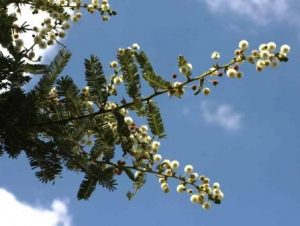
Acacia rehmanniana. Photo: Bart Wursten. Source: Flora of Zimbabwe
A. rehmanniana has extremely minute leaflets and pinna, covered in fine soft down. From a distance it sometimes resembles A. karroo, as it has the same dark sooty rust coloured branches. However, A. karroo has larger and quite glabrous leaflets. The thorns occur mainly on the new wood. A. abyssinica (Inyanga flat top) also bears a few thorns on the old wood and has a very pale, extremely flaky bark. It resembles A. sieberiana with which it shares the habitat in the Penhalonga valley. The fruits are very different; that of A. abyssinica is a flat pod, that of A. sieberiana is a large thick nondehiscent fruit. In general of course, these straight thorned species have ball shaped flowers. Our thanks to Tom for his methodical approach, and for his time.
-C.Haxen
MAZOWE CITRUS ESTATE, NOVEMBER 1989 :
The morning’s walk was through a patch of well developed miombo woodland at the base of a hill where many interesting trees grew into tall specimens. But having just had flue and then cycled out to Mazowe I was not prepared for the violent attack on arrival. Almost as soon as we began looking at the first tree the attack had begun. Some insect (presumably an ant) had climbed right up into my pants and then released some chemical that results in an overall burning sensation, it does not feel like a single bite. I remember being attacked once in the Mukuvisi Woodlands when I was giving a more formal lecture to headmasters and heads of departments – on that occasion I continued talking while wiping away the tears. This time I was less circumspect and set about hunting the beasts – only to squash two ants beyond recognition so I am none the wiser as to their identification. I was not the only victim for the morning, many of our group were attacked soon afterwards, and on the return the other group suffered as well. The burning drives one to distraction for about 10 to 15 minutes and then you wonder what you were complaining about.
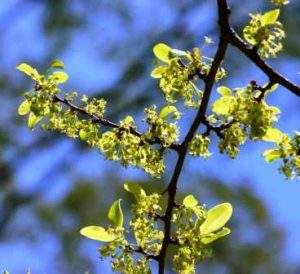
Margaritaria discoidea. Photo: Bart Wursten. Source: Flora of Zimbabwe
By the time it had stopped we had already looked at Zanha africana in fresh green leaf and covered in green fruit, Margaritaria discoidea also in new leaf and thus not quite itself and Commiphora mossambicensis with leaflets like apricot leaves and a distinct peppery smell. Not too far off were C. africana and C. marlothii with their attractive peeling barks. All were in full leaf following the early rains this year. After examining the typical horizontal cracks in the bark of Ochna schweinfurthiana and the vertical fissures of Vitex payos we headed onto the rocks to look at the fan shaped leaves on the fern Actiniopteris dimorpha. Yes, this is still the Tree Society but as I am busy working on a key to Zimbabwean ferns for my students these diversions are fairly important. Above us stood a a spreading Afzelia quanzensis, it was Anne Bianchi who pointed out the distinct translucent margin to each leaf and the twisted petiolules they work well. The violet trees Securidaca longipedunculata have been magnificent this year but most of the specimens we saw were past flowering.

Turraea nilotica. Photo: Sue Holt. Source: Flora of Zimbabwe
One of the most attractive sights for the day was fruit on Turraea nilotica. The fat berries peel open to reveal many segments each with a tomato red aril and black seed – classic colours for bird aril and black seed – classic colours for bird distribution. Many of the trees were still leafless.
We were also able to compare the large leaved Uapaca kirkiana with U. nitida. Both have surprisingly hard to woody juvenile leaves. By this time we were standing in a closed canopy forest of tall mukwa (Pterocarpus angolensis), Brachystegia glaucescens and a strange Parinari curatellifolia that had a Z-shaped trunk which resembled a buck’s head. Nearby I struggled to identify what turned out to be Kirkia acuminata. The leaves were fine but the trunk had many short dead branches and the base had become decidedly corky. Other finds for the morning included Maerua angolensis in small fruit, Ficus glumosa and Vernt (alias Tarzan) discovered a bed of ‘more than 40’ black arums, Amorphophellas, amongst the rocks on the kopje.
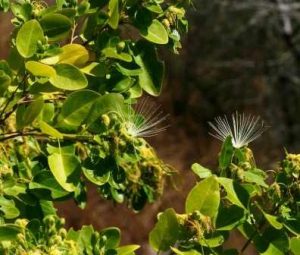
Maerua angolensis. Photo: Bart Wursten. Source: Flora of Zimbabwe
After a peaceful lunch in the shade of enormous gums at the side of the dam we explored the forest below the dam wall (that sentence may confuse English readers, to go for a walk on the dam is acceptable in Britain, but nothing short of being miraculous here). This tall forest of Celtis africana, Pterocarpus angolensis, and Combretum erythrophyllum has a number of interesting species in the under storey. Acokanthera oppositifolia displayed its milky sap,
Ekebergia capensis are plentiful, we found the specimen that the herbarium identified as Zanhna golungensis after our last visit, a small Schrebera alata grew alongside and Osyris lanceolata. It is not always wise to grow alongside an Osyris, they belong to the SANTALACEAE, a family that is often parasitic on the roots of other plants. I cannot find a reference to show that Osyris has been proved to be parasitic, but it probably is. Members of the SANTALACEAE attach themselves to the roots of almost any plants that they come across. Johan Visser in his book on South African Parasitic flowering Plants records one individual that had connected itself to all plants that grew with a radius of 5 metres, these included shrubs, herbs, and grasses belonging to 15 different families (I suspect there were no trees in the area). One day we need to spend some time with Osyris.
Still feeling somewhat drained of energy and lethargic we headed to the orange kiosk for a welcome drink, here we also examined all the figs – Ficus salicifolia, F. ingens, f. thonningii, f. sur and F. sycamorus that all grow around the kiosk quite naturally. All in all a worthwhile tree day, thanks to the organizers and the Mazowe folks.
-Kim Damstra
FROM AYSHIRE DISTRICT
Whilst on holiday in New South Wales we stayed near a Forest Reserve of Eucalyptus woodland. Here I found the minute red rosette of an insectivorous plant called Drosera spathulifolia. I returned to this plant with a young grandchild, it was an adventure for us to crawl about the forest floor looking for a sundew having a meal. Into a hat went a plant which had trapped little black ants. The small girl and the delicate Sundew had to be carried across soggy places on the way home. The plant flowered in captivity. The memory of its beauty will endure. Dodonaea similar to ours here grew in the coastal scrub on the sand dunes on the way to the beach.
BOTANICAL PARADISE NYARUDINDA CATCHMENT – In Zimbabwe again, the pre-dawn jet lagged awakening on the first morning at home was eased by the sound of honey bees close to the house. They were collecting nectar from the sweetly scented green flowers with black hairs of Mufuti Brachystegia boehmii. These flowers sometimes pass unnoticed amidst Prince of Wales Feathers, mufuti is most frequent on clayey gravels where it may become the dominant tree. “Gudza” articles are made from its inner bark, e.g. the wide brimmed string hats are cool to wear because the wind blows through the crown. The loose strings lends an air of mystery to the visage and wards of skin damaging rays.
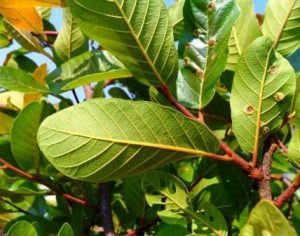
Monotes glaber. Photo: Bill Clarke. Source: Flora of Zimbabwe
Many horse rides and walks have revealed the happenings in the bush. The country side in October and November fills our senses. The sounds are Mupupu the African Hoopoe, cuckoos, whistling duck and Christmas Beetles. The scents are too numerous to describe. Now is the time to look at unfolding leaves, nectaries and flowers, their freshness is short-lived in this hot dry pre-rainy season. The new leaves of Monotes glaber have moist bright red nectar glands, these must be important. Those of Monotes engleri (growing beside the house) remain a secret as the tree is still dormant. Nectaries are usually in flowers and nectaries elsewhere on a plant are extra floral.
Glands of some sort are very prominent on the trifoliolate leaf of Erythrina species. There are two knobs at the base of the terminal leaflet and one at the base of each lateral leaflet. Perhaps these are nectaries. Erythrinas generally are hosts to many different kinds of insects. It is difficult to maintain the trees (on the drive to the house) in good order. The genus Erythrina has not had the attention by botanists that it deserves. It does not feature yet in Flora Zambesiaca. Reference books obtainable locally do not even mention these little glands.
Every month one species from each environment listed in the article “Middle Catchment of the Nyarupinda River” will be examined.
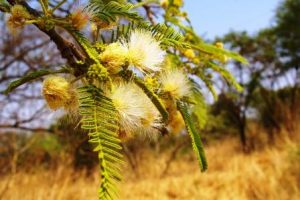
Albizia amara. Photo: Meg Coates Palgrave. Source: Flora of Zimbabwe
Albizia amara – Magarahanga – (where the guinea fowl stays) is coming into flower amongst the new leaves. This occurs on a variety of soil types. It thrives on sand veld in low rainfall areas such as ours. In wetter areas it is found on anthills which are naturally well drained.
There are several Olax obtusifolia in the quartz rubble on the edge of the garden. Olax means with an odour. At this moment last year’s wood bears a profusion of creamy green minute tubular flowers which are scented, and full sized green spherical drupes – each has a hard seed enclosed completely by a ‘rind’ of calyx – this is rather unusual. The ripe fruit is red and relished by elephants, it is of no culinary use. Olax new growth is slender thin textured and blue green in colour, it seems too fragile to cope with its dry habitat. A waxy bloom develops to protect the leaves as they mature. What a joyful transformation in my absence. Olax is rather smutty and bonsai for much of the year.
Ochna gambleoides occurs in an exposed position beyond the Olax. The tallest is over three metres high, perhaps it is playing for time and not yet old enough to flower. This event will be good news.
Terminalia mollis grows on vlei margins, it tolerates a fluctuating water table. It is a noble tree too often cut down for paddock fencing, and is the host of the Topinanthes parasite. At the moment the rosettes of hand span size soft new apple green leaves have a velvety feel. Old fruits blackened with age hang aloft. This species has the largest fruits of all the local Terminalias. The reticulating bark is another attribute of all Terminalias.
An action packed anthill opposite the end of the drive bears a dome of misty mauve in shimmering heat, this is Ehretia amoena – it belongs to the forget-me-not family and is a tree much loved by insects. The flowers are scented and very small and beautiful.
The Marula tree is quite rare in Ayrshire district. There is just one on a passive flat Termitarium just a short distance from the house. Both male and bisexual maroon flowers with white glistening stamens are in bloom on short stout branches now. In Skyf’s Insect book there is a photo of an enlarged Marula flower, it is worth looking at. Earlier in the year this tree yielded a few fruits. I shall watch for this season’s crop in May 1990.
On a riverine anthill at the confluence of gorges on Chepstow farm there appears to be one (so far) specimen of Aphloia theiformis. The leaf has a glossy surface and a drip tip. Starlike remains of papery calyx and stamens float in the lily pool under the high banks. All that needs to be found to confirm this is the albino berries. I would like someone to identify this tree. Trevor Gordon found albino berry near the source of the Susuje river in the Great Dyke not far from here, so it is not alien to this part of Zimbabwe.
Pappea capensis sprawls over an anthill watered seasonally by the dam. Fruit and flowers are accessible. Some confusion about the fruits has arisen – descriptions in textbooks do not seem to explain what is found. Abortion of some fruits affects the final appearance – could be the explanation. Young fruits are 3-partite.
One final paragraph to record the presence of an orchid which could be associated with Muzhanje – Uapaca kirkiana. This occurs in the garden and looks like a little mud wasp on a short dry grass stem. It is yellow inside and maroon or liver coloured in the diminutive trumpet. At the posterior of the flower three translucent wings stand erect. It may not be rare but is very easily overlooked. An Orchid flower stalk (peduncle) is actually the ovary, they are very specialised morphologically.
Here ends the report on the botanical paradise for October.
-Benidicta Graves
MUKUVISI WOODLAND WALK : 28 OCTOBER 1989 –
A party of 6 gathered at the Paget Road entrance to the Mukuvisi Woodland. Just across the concrete bridge on the bank of the river was the striking orange-red flowering shrub Sesbania punicea. This shrub is a garden escapee, which has become well established in ditches and by streams in parts of Harare.
On the burnt, open area north of the river was a magnificent display of flowering shrubs and plants, many of which incidentally are in Meg Coates Palgrave’s recently published “Guide”.
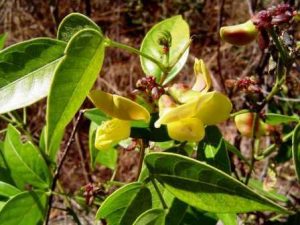
Sphenostylis marqinata. Photo: Bart Wursten. Source: Flora of Zimbabwe
Most striking, perhaps, were the low, blue tufts of Pentanisia schweinfurthii, RUBIACEAE. However, there was also yellow flowered Sphenostylis marginata, white flowered Trichodesma physaloides, blue flowered Thunbergia lancifolia and purple flowered Dolichos kilomandscharious which gave the area the appearance of a garden. We examined and smelt the strongly lemon scented racemes of the grass Elionurus muticus.
In the woodland, we saw four species of Rhus, Vernonia glaberrima in bud, Commiphora africana in new leaf and, tangled up together which caused at first some confusion, were Turraea nilotica, still just in flower, and Clerodendron wildii in fruit.
By the river was our second Sesbania, S. macrantha, this time with yellow flowers, Swartzia madagascariensis in flower, and two Syzygiums, S. cordatum and S. huillense.
Such was the keenness of the group that we walked for three hours in all through the woodland and saw a large number of trees, shrubs and plants.
-M.A. Hyde
TREE NOTES FROM MUTARE
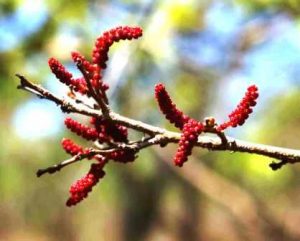
Hymenocardia acida, Photo: Meg Coates Palgrave
Thompson’s Vlei, Mutare is blessed with several clumps of Hymenocardia acida, very distinctive with its pale white grey bark with the red under bark showing through. The colonies are in full male flower, spikes of tiny Erica, like red flowers – with the new rust orange leaves appearing. There is no sign yet of the female flowers. Also in flower are the yellow shaving brushes, sweetly scented of Albizia amara, the jasmine scented Carissa edulis and bispinosa and the very common Erythroxylum emarginatum which has single fascile axillary, delicate, white flowers. Both Pericopsis angolensis and Securidaca longipedunculata are in competition showing off their purple blooms. The Muwanga has beautiful sprays of mauve pea like flowers, but is totally out done by the violet trees which are so vivid they stand out like femmes fatale! Unfortunately there is no cure for the poisoning for which this tree is famous. The roots and bark are used for murder and for abortion. By just inserting these into the rectum or vagina death ensures hours or days later, once the poison is absorbed through the mucous membranes. The roots also contain methyl silicylate (oil of wintergreen) a common ingredient in rubefacients today. Acacia sieberiana are in full bloom with their cream colour balls and are an insect haven. Vangueriopsis lanciflora is just coming into flower, the inconspicuous cream coloured lobes are appearing with the new leaves instead of before.
-Gail Henning
CHIKWENYA NOTES – OCTOBER/NOVEMBER 1989
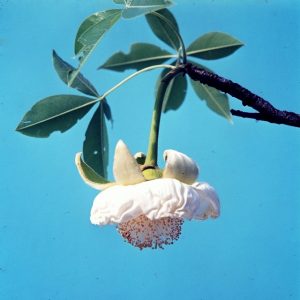
Adonsonia digitata. Photo: Mike Bingham. Source: Flora of Zimbabwe
To date we have still had no rain here (9th November), but it is amazing how much of the ‘bush’ has come into fresh, new leaf, despite the lack of moisture, so there is a startling contrast between the tender, bright greens and the baked hard ground. The baobabs (Adansonia digitata) have come into leaf, and have also been flowering, big white, cup flowers pollinated by bats. The Trichillea emetica have changed their leaves without ever being bare, the new leaves pushed the old ones off, so they are looking spruce and shiny in their new ‘coats’ their round fruits are just beginning to show.
The Crossopteryx febrifuga are sending out brick red leaf shoots again which makes more sense now than it did in the autumn. Some of the Lonchocarpus capassa put out new leaves, but were completely stripped by a caterpillar and will have to try again.
Many species have been flowering, the Pterocarpus antunesii were particularly bright this year, and yellow splashes in the jesse. The Cordia goetzei has been showering down drifts of small fine pale flowers. The Croton megalobotrys has been perfuming the evening air. The pod mahogany, Afzelia quanzensis, have been dropping their green and crimson flowers, eagerly consumed by the bush buck. The Albizia brevifolia were covered in their delicate filigree blossom, and also come into new leaf. The Byrsocarpus orientalis and the Baphia massaiensis are still flowering.
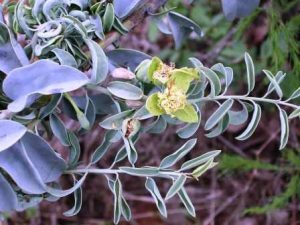
Courbonia glauca. Photo: Colin Wenham. Source: Flora of Zimbabwe
Some of the Coffea have had a sporadic flowering, but nothing like the mass outburst we had last year, which was induced by the heavy early storm in October.
The grey leaved Courbonia glauca are heavily in fruit.
The Faidherbia albida are still dropping curly pods, a vital source of sustenance for the game with this on going dryness. Some of the albidas are just beginning to loose their leaves and to look a bit thread bare, having the opposite cycle to everything else.
We will soon be packing up camp, and leaving the area to regenerate in peace during the rains.
-EB/VS/JS/PW
MUKUVISI WOODLAND NOTES
This month to finalize an introduction to the Woodland I would like to briefly discuss the vegetation types we have, but first a little unfinished business from last month’s historical introduction.
Last month in tracing part of the history of the preservation of the Mukuvisi Woodland I brought to readers of Tree Life a reproduction of portions of a letter from Mr. Dick Petheram. I am sorry to say that due to the intrusion of gremlins, the reproduction was not all it might have been. I hope though, that the general tenor of Dick’s letter will have got across and that something of significance of this society’s past association with the Woodland, initially inspired by Doug Aylen, will have been noted.
The gremlins were all of my making, I take full responsibility for the errors in transcription.
Still basically historical, I now wish to trace the vegetation types we defined at the start of the first Woodland training course in 1981, we sketched out six basic areas;
- north east section; Brachystegia – Parinari mixed species woodland with grassy glades, all suggesting a fairly good ground water position
- south east; Brachystegia – Julbernardia with much recent regeneration suggesting both lower water table and recent recovery from land abuse.
- south west; Brachystegia – Monotes – Burkea with some parts mature woodland with well established understorey species.
- north west; the Chiraura vlei, ninety nine per cent treeless, with vigorous grass growth
- the riverine strip, the whole length of the Mukuvisi River line and along the Chiraura up to start of the north west area. Very variable riverine vegetation depending on stage of succession from degradation in first half of this century.
- the demonstration zone, completely man modified, little indigenous vegetation, lines of exotics following former fence lines of the municipal twelve acre plots.
From here we will go on next month to examining the vegetation as it is now.
-G.Hall
ROOTNOTE Everyone seems to understand basic zoology. If asked to arrange a frog in the progression jellyfish, shark, lizard, bird they will put the frog between the shark and the lizard. But if asked to put the BIGNONIACEAE (jacaranda family) into sequence STRELITZIACEAE (strelitzia family) CAESALPINIOIDEAE (Cassia family) RUBIACEAE (gardenia family, they fall apart as if they were being asked to translate ancient Arabic. And yet it is not very difficult, certainly not beyond any of us, if we know three easy rules:
- All parallel veined leaves (e.g. strelitzia) are conventionally placed before net veined leaves (cassia, gardenia and jacaranda).
- Net veined leaves with separate petals (think of a cassia flower) are placed before fused petals (visualize a tube like gardenia and jacaranda).
- Fruit that sits below the flower (remember a gardenia where the remains of the flower remains on the end of the ripening fruit) is considered a more advanced feature than fruit that develops within the petals (as in a jacaranda). So on this basis the BIGNONIACEAE (jacaranda family) falls between the CAESALPINIOIDEAE (Cassia) and a RUBACEAE (gardenia). One eventually gets to know where to find the Biblical books by their “almost” chronological sequence, yet as we are always consulting books like “Trees of Southern Africa” Coates Palgrave) it will help us a lot to get a basic idea of how things are arranged – it will also open up the arrangements in most of our Southern Africa herbaria which follows the arrangement of the botanists Engler and Prantl. This is not a real classification and does have a couple of flaws.
-Kim Damstra
DICK HICKS CHAIRMAN


